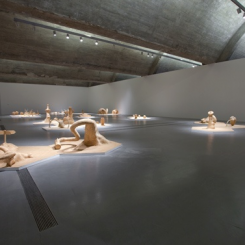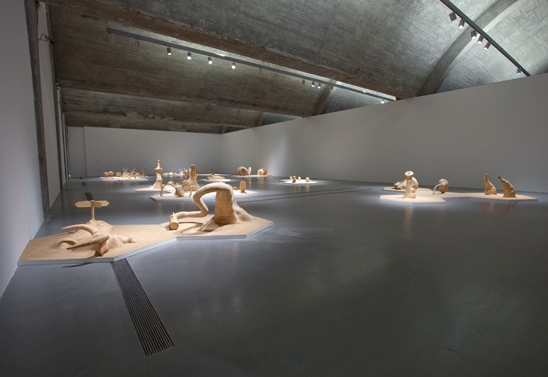Sasha Zhao: Bamboo items appeared in your exhibition “Breaking through the Ice” at the Ullens Center for Contemporary Art in 2009, in which bamboo objects of different forms appeared to grow out from bamboo mats. How is this current exhibition, which again utilizes bamboo as a material, related to the previous project? Bamboo strongly implies Chinese cultural imagery, as with the “Seven Sages of the Bamboo Grove” in the Wei and Jin dynasties or the understanding of the “unity of knowledge and practice” that Wang Yangming achieved through investigating bamboo in the Ming period. What triggered you to return to this “investigation of bamboo” with your literati sensibility? Is this a continuation of the cultural archaeology and imagination of “Qiu’s Notes”?
Qiu Zhijie: Bamboo is indeed a significant element in Chinese culture, but in the process of using it for my work I did not intend to emphasize it as a particularly Chinese cultural element. Of course, my use of bamboo items, beginning with “Interface” and “My 72 Transformations,” has involved a certain recollection of childhood. Bamboo objects evoke memories connected to the recently passed agrarian age. In our present living environment—increasingly virtual and textual—such highly textural materials represent a lifestyle that is almost abandoned. In memory, however, this lifestyle involves a warm and pliable strength. Humanity is losing itself in a torrent of motivational self-improvement and futurism, while there is hidden in the bamboo forest another kind of philosophy.
In this sense I do not stress the blood relationship between bamboo and Chinese culture; in fact, other cultures also have profound knowledges of bamboo. The refinement of Japanese bamboo craft, for example, remains high even today, while a number of other countries take bamboo as an environmentally friendly building material for sustainable development—a kind of bamboo reinforcement to replace steel—and have seen great success. We cannot remain overly immersed in our own stories. Actually, artisanal bamboo weaving in the Chinese tradition is currently leaving the stage of history. Such craftsmen working with bamboo strips are now difficult to find under 40 years old in many places.
The fact that bamboo appears in this work is not directly related to the tradition of the “Seven Sages of the Bamboo Grove,” which assumes bamboo as a metaphorical representation of culture and character. But it is related to the story of Wang Yangming investigating bamboo. While weaving with the bamboo strips I reconsidered the nature of modeling.
The entire production tends toward the confirmation of “principle,” not in terms of “theory” or “rationality” but rather what the Chinese call “sense” or “reason.” Just as bamboo has joints and veins that constitute the principle along which the hands can work, giving rise to both the image and the art of the phrase “as easy as splitting bamboo,” so should other things grow outward according to their inner principles.




